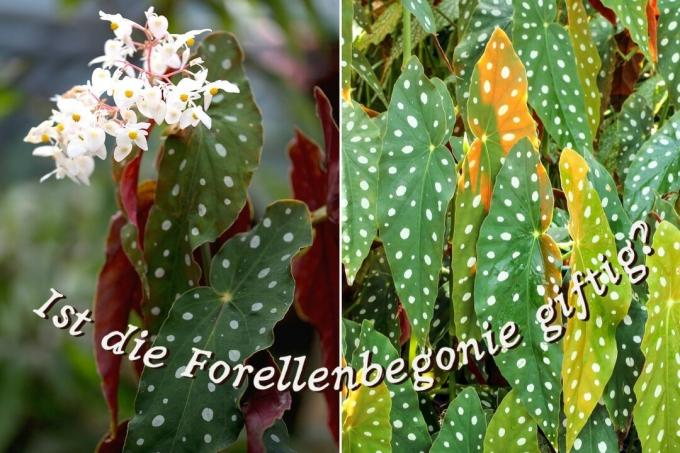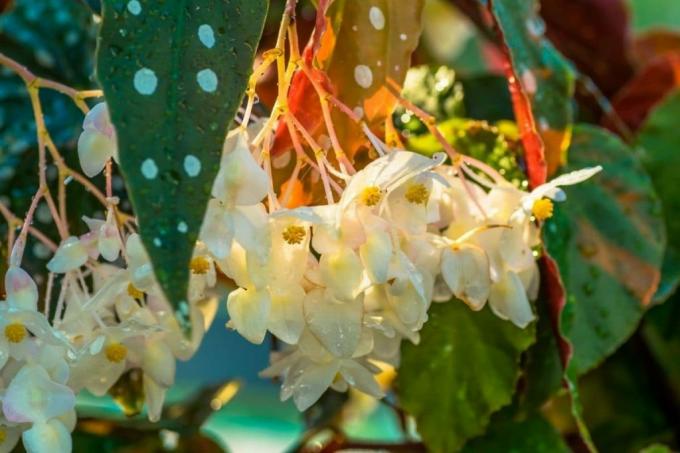
table of contents
- Toxic or not?
- Poisonous plant parts
- Contained poisons
- Possible effects
- Toxic to animals for which species?
- frequently asked Questions
Begonia maculata, the Trout Begonia, enjoys great popularity because of its clearly drawn leaves. But is it really easy to keep in the apartment? Or is the beautiful trout begonia even poisonous?
In a nutshell
- Trout begonia juice is poisonous
- The symptoms of poisoning are caused by oxalic acid and calcium oxalate
- Small mammals and birds should avoid Begonia maculata
Toxic or not?
The question of whether the trout begonia is poisonous can be answered with a clear yes. Although not all species of Begonia maculata are to be assessed as critical and especially mildly poisonous specimens are more likely Unpleasant and actually dangerous is the situation with the species also known as polka-dot begonia clearly. Children and old people in particular, but also every other person who has intensive contact with the plant, can be affected.
Poisonous plant parts
The danger comes from the juice of the begonia, more precisely from its ingredients. Therefore, in the end, all components of the plant through which the plant sap flows must be included in the analysis:

- Stems
- leaves
- blossoms
- root
Note: While the roots are comparatively dry and therefore not very dangerous, the heavily flowed styles and flowers are particularly critical plant components!
Contained poisons
Two substances in particular are responsible for the fact that trout begonia is poisonous:
- Oxalic acid
- Calcium oxalate
Both substances are present in numerous plants that are generally regarded as uncritical and are sometimes even eaten. For example, here is rhubarb to call. However, the safety is justified there “only” by the quantities contained. In the trout begonia, both ingredients have such a massive effect that the note "toxic" is appropriate and applicable in any case.
Possible effects
The consequences of contact with the plants are wide-ranging and usually range in the following framework:
- Redness of the skin
- Irritations of the mucous membranes
- nausea
- Vomit
- Diarrhea (less often)
- Shortness of breath
- temporary or permanent impairment of vision (with direct eye contact)

Note: Even if the sap does not show immediate effects on your hands and fingers, you should wash your hands thoroughly after each contact. From the hands, however, the substances quickly get into the mouth and eyes even after hours through unintentional contact.
Toxic to animals for which species?
In addition to humans, various animal species also suffer from the poison of the trout begonia:
- dogs
- Cats
- Small mammals, like Rabbits, Hamsters, guinea pigs
- Birds
- Livestock (for large quantities, e.g. B. after eating plants or parts of plants)
As you can easily see, the trout begonia is poisonous to most common domestic animals, so keeping pets in Community with this begonia species and other members of this species family classified as critical, taking at least some precautionary measures requirement.
frequently asked Questions
If the sap gets on the skin or mucous membranes, you should rinse the affected areas thoroughly with plenty of water. In the event of swallowing, it is advisable to see a doctor in any case. If you experience severe symptoms, you must call an emergency doctor.
Calcium oxalate, one of the toxins contained in polka-dot begonia, is closely related to the more well-known and also contained oxalic acid. This is a salt of oxalic acid that results from a reaction with the calcium in the plants.
On the one hand, this salt of oxalic acid is contained in many poisonous plants. On the other hand, it is also the main component of the kidney stones that recur and cause discomfort in humans. They can arise when the kidneys have to process a lot of oxalic acid from the human body.



